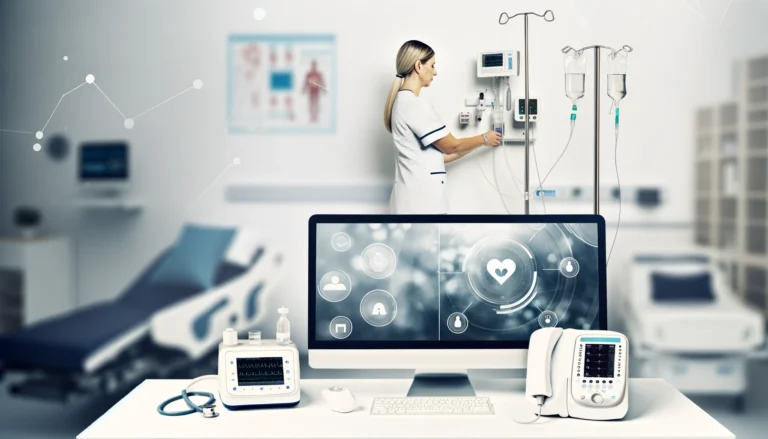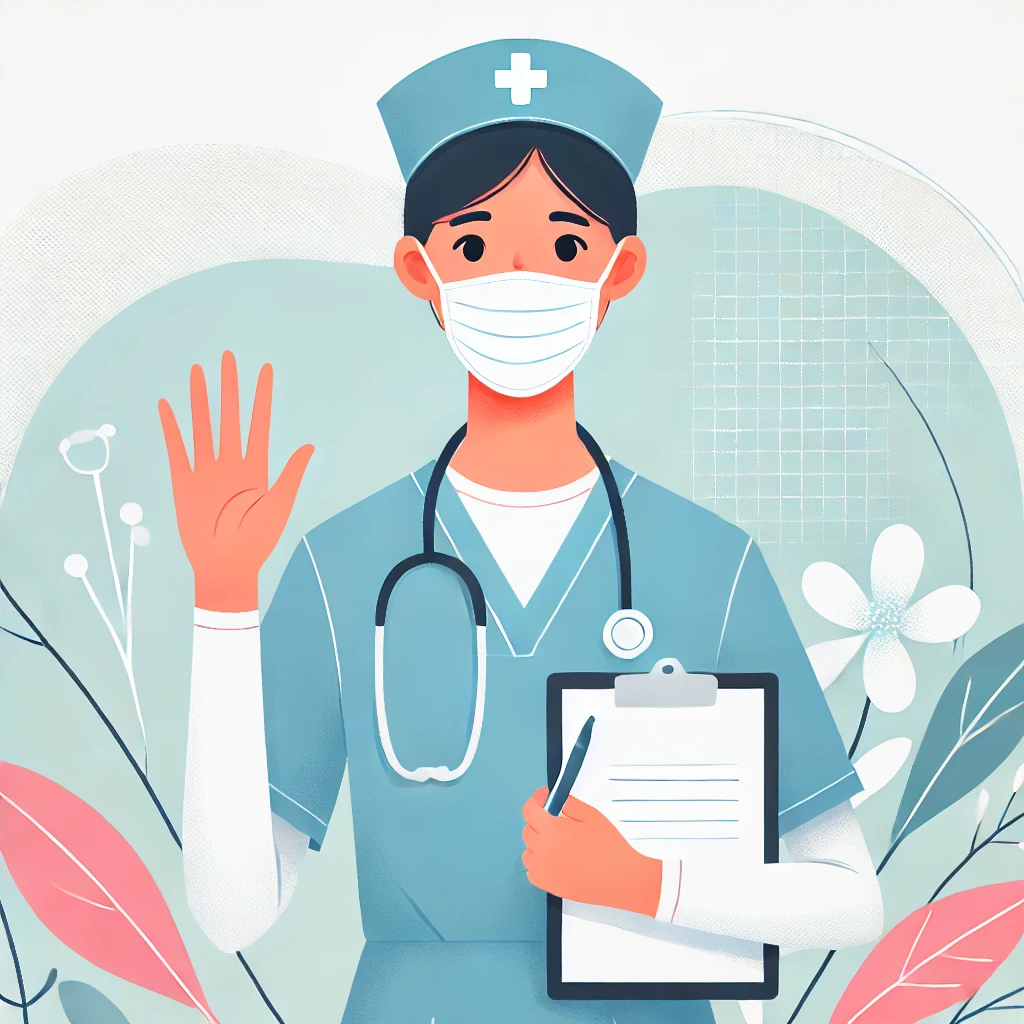Nursing
How I Use Technology to Enhance My Nursing Practice


We recently spoke to a nurse who has been working at a leading hospital in Chicago for the past seven years. Here is her journey and the insights she has to offer.
“As a nurse, technology has seamlessly penetrated every aspect of my practice. Technological innovations have profoundly influenced how I approach my daily responsibilities, from bettering patient care to optimizing administrative workflows. Here is how technology shapes nursing today: the common concerns about whether nurses can be replaced by technology and the latest trends driving our profession’s evolution.
How Does Technology Affect Nursing
If you have ever wondered how to become a nurse practitioner, I will tell you that today is much easier than a few years ago due to the emergency of technologies.
Enhanced Patient Care Technological tools like Electronic Health Records (EHRs) and Electronic Medication Administration Records (eMAR) have revolutionized patient care. EHRs ensure that all healthcare team members have instant access to accurate, up-to-date patient information, leading to better coordination and reduced chances of medical errors. These systems streamline documentation and communication, making it easier for nurses to provide high-quality care.
Increased Efficiency and Time Management The introduction of automated systems such as IV pumps, smart infusion devices, and mobile diagnostic tools has drastically improved nursing efficiency. These technologies take over routine tasks, giving nurses more time to focus on patient-centered care. For example, smart beds with sensors can track patient movements and vital signs, reducing the likelihood of falls and enabling quicker responses to emergencies.
Expansion of Telehealth and Remote Monitoring Telehealth technology has opened up new avenues for patient care, particularly for those in rural or underserved areas. Through telehealth platforms, nurses can conduct virtual consultations, monitor patients remotely, and provide continuous care without needing in-person visits. This is especially valuable for managing chronic conditions and reducing the need for hospitalizations, ultimately improving patient outcomes.
Improved Patient Safety and Error Reduction Technologies like barcoded medication administration systems and smart pumps enhance patient safety. These tools ensure accurate medication dosing and administration, significantly lowering the risk of errors. Automated systems with built-in alerts and reminders help nurses adhere to treatment protocols, maintaining high patient safety standards in even the most critical environments.

Write Your Nursing Essays with Expert Help!
Struggling to balance your nursing studies with clinical practice? Let us help you write high-quality essays!
Can Nurses Be Replaced By Technology
While technology has undeniably advanced the nursing field, it cannot replace the crucial human connection at the heart of patient care. Nursing is not just about administering treatments; it’s about understanding, comforting, and empathizing with patients, aspects that no machine or software can replicate.
Technological tools like Electronic Health Records (EHRs) and automated medication administration systems have transformed how nurses deliver care. These innovations provide real-time access to patient data, enabling more accurate and timely interventions and reducing the likelihood of errors. However, the ability to interpret a patient’s emotional and psychological state, offer reassurance during stressful times, and build trust through personal interaction remains a uniquely human capability.
Robots and AI can perform repetitive tasks efficiently, but they cannot perceive or respond to the subtleties of human emotion. For example, a nurse’s comforting presence during a complex procedure or ability to interpret non-verbal cues can significantly affect a patient’s experience. Therefore, while technology enhances the quality and efficiency of care, the compassionate, human element nurses provide ensures holistic patient care.
Recent Trends and Advancements in Nursing Careers
Trend/Technology 🔥 | Description 📄 |
Health Informatics 💻 | Health informatics is now a critical specialization, leveraging data from IT systems to enhance patient care. Nurses specializing in informatics help manage and analyze health data, contributing to improved decision-making and outcomes. |
Portable Diagnostic Devices 🩺 | Handheld EKGs and portable ultrasound machines allow for quick and efficient diagnostics. These devices are especially useful in home health care and for patients with mobility challenges, offering greater flexibility in patient care. |
Wearable Technology ⌚ | Wearable devices continuously monitor vital signs and transmit real-time data to healthcare providers. This technology is essential for managing chronic conditions and ensuring timely medical interventions. |
Artificial Intelligence (AI) and Robotics 🤖 | AI and robotics are increasingly used in nursing for predictive analytics and routine task automation. These advancements improve efficiency and accuracy, allowing nurses to focus on patient-centered care. |
Telehealth Expansion 🌐 | The expansion of telehealth services, accelerated by the COVID-19 pandemic, remains vital for accessible care. Telehealth supports remote consultations and chronic disease management, ensuring continuity of care across locations. |
Bilingual Nurses 🌍 | As the U.S. population becomes more diverse, the demand for bilingual nurses, especially those fluent in Spanish, is growing. Bilingual skills enhance communication and care quality for a broader patient demographic. |
Specialization in Nursing 🏅 | Increasing numbers of nurses specialize in family health, psychiatry, and critical care. Specialization meets the rising demand for advanced skills and allows nurses to earn higher salaries. |
Holistic Care 🌿 | Holistic nursing, focusing on the complete well-being of patients—physical, mental, emotional, spiritual, and environmental—is gaining traction. This approach has been shown to improve patient outcomes and overall satisfaction. |
Mobile Device Usage 📱 | The use of mobile devices by bedside nurses has surged, improving communication, documentation, and access to information. This trend integrates technology further into daily nursing practices, enhancing efficiency and care quality. |
What is Virtual Simulation
As a nurse, I’ve experienced how virtual simulation revolutionizes nursing education. This cutting-edge tool offers an immersive, hands-on training experience, enabling nursing students to hone their skills in a risk-free, controlled environment. Here’s how virtual simulation is making a difference in my practice and advancing nursing education.
Virtual simulation in nursing involves the use of sophisticated computer programs to create lifelike clinical scenarios. These simulations can range from routine tasks, such as taking vital signs, to more complex situations, like managing a patient in cardiac arrest. The purpose is to replicate real-world clinical settings as accurately as possible, providing students with valuable practice without the potential risks of working with actual patients.
Benefits of Virtual Simulation in Nursing Education
Benefit 🌟 | Description 📄 |
Enhanced Learning Experience 🎓 | Virtual simulation delivers an engaging and interactive learning experience. The ability to repeatedly practice clinical skills until reaching proficiency is invaluable. Research shows that students who engage in virtual simulations develop stronger critical thinking and clinical reasoning skills, better preparing them for real-life challenges. |
Safe Learning Environment 🏥 | One of the key advantages of virtual simulation is the opportunity to learn in a risk-free environment. This is essential in healthcare education, where mistakes can have serious consequences. Virtual simulation allows students to experiment, learn from errors, and build confidence, all without the risk of harming actual patients. |
Accessibility and Flexibility 🌐 | Virtual simulations can be accessed from anywhere, making them perfect for remote learning. This flexibility proved crucial during the COVID-19 pandemic when access to clinical sites was limited. Many institutions have integrated virtual simulation into their programs to ensure uninterrupted training, providing students with continuous learning opportunities. |
Standardized Training 📚 | Virtual simulation offers standardized training experiences, ensuring consistency across the board. Unlike traditional clinical settings, where patient cases and instructor availability vary, virtual simulations provide a uniform training process. This ensures that all students can practice various scenarios, regardless of location or circumstances. |
Immediate Feedback and Assessment 📝 | Many virtual simulation platforms provide real-time feedback and detailed performance assessments. This immediate feedback is crucial for identifying areas for improvement and helps instructors tailor their teaching to address specific needs. Studies indicate that timely feedback is essential for effective learning and skill development. |
Implementing Virtual Simulation in Nursing Curricula
Successfully integrating virtual simulation into nursing curricula requires thoughtful planning and resource allocation. Here’s how to approach this process effectively:
Choosing the Appropriate Platform Selecting the right virtual simulation platform is essential for maximizing educational outcomes. Platforms like SimChart, Body Interact, and vSim for Nursing offer diverse scenarios tailored for nursing education. These platforms provide interactive patient cases, immediate feedback, and comprehensive analytics to monitor student progress, ensuring a well-rounded learning experience.
Training Educators and Learners To fully leverage virtual simulation technology, educators and students must receive adequate training. Faculty should be well-versed in using and integrating simulation tools into their teaching strategies. Likewise, students need orientation sessions to understand how to navigate and apply the simulations in their studies.
Integrating Simulations into the Curriculum Virtual simulations should be strategically embedded within the nursing curriculum to enhance traditional teaching methods. This includes utilizing simulations for foundational skill development, reinforcing classroom instruction, and evaluating student competency. Combining these simulations with other advanced technologies, such as virtual and augmented reality, can enrich the educational experience.
Evaluating Outcomes: Continuous evaluation is critical in gauging the effectiveness of virtual simulations in attaining educational goals. This includes gathering data on student performance, instructor feedback, and clinical practice outcomes. Institutions should use this data to refine their simulation programs and meet the changing nursing education needs.
Challenges and Future Directions
While the benefits of virtual simulation in nursing education are significant, several challenges must be addressed. The upfront investment in simulation technology can be substantial, requiring institutions to commit resources for the initial purchase and ongoing maintenance and software updates. Additionally, integrating new technologies into the curriculum often involves a steep learning curve, necessitating extra support and training for faculty and students.
Despite these challenges, the future of virtual simulation in nursing looks bright. Technological advancements, particularly in artificial intelligence (AI) and machine learning, are poised to elevate simulations’ effectiveness further. AI-powered simulations have the potential to offer adaptive learning experiences, adjusting scenarios in real-time based on individual student performance, thus providing a more personalized and practical educational experience.
Moreover, the continued development of virtual reality (VR) and augmented reality (AR) technologies promises to transform how nursing students engage with simulations. These immersive tools can create lifelike, 3D environments where students can practice complex procedures and patient care more dynamically and interactively, pushing the boundaries of traditional nursing education.
If you need to write a capstone project on nursing capstone project ideas, our experts are ready to help anytime.
Summing Up
Integrating technology in nursing has revolutionized the field, offering significant improvements in patient care, efficiency, and safety. However, balancing leveraging these advancements and preserving the essential human connection central to nursing is crucial. By staying informed about the latest technological trends and thoughtfully incorporating them into practice, nurses can continue to deliver high-quality, compassionate care in an ever-changing healthcare environment.
For more detailed insights on the duration of nursing programs, check out how long is nursing school.
For a deeper dive into how technology is transforming nursing and to explore future trends in nursing careers, be sure to stay informed and adapt as innovations emerge. Embracing these tools enhances patient outcomes and helps mitigate nurses’ challenges, contributing to better overall care and job satisfaction.”

Master Your Nursing Assignments with Expert Assistance!
Overwhelmed with nursing assignments and tight deadlines? Our team of professional writers is here to help.
FAQs
How is information technology used in nursing?
Information technology (IT) is extensively used in nursing to enhance patient care, streamline administrative tasks, and improve communication within healthcare teams. Key applications include Electronic Health Records (EHRs) for real-time access to patient data, telehealth platforms for remote consultations, and automated medication administration and monitoring systems. IT also supports nursing education through virtual simulations and online learning resources, helping nurses stay updated with the latest medical practices.
What is the use of virtual simulation in nursing?
In nursing education, virtual simulation provides students with realistic, hands-on training experiences in a controlled, risk-free environment. It allows nursing students to practice and refine their clinical skills by engaging in simulated patient care scenarios, ranging from routine tasks to complex emergencies. This technology enhances learning by offering interactive, immersive experiences that prepare students for real-world clinical settings without the risk of harming actual patients.
What is a disadvantage of technology in nursing practice?
One disadvantage of technology in nursing practice is the potential for depersonalization of patient care. While technology streamlines processes and improves efficiency, there is a risk that the increased focus on devices and data could reduce the amount of direct, personal interaction between nurses and patients. Additionally, the reliance on technology can lead to challenges such as technical malfunctions, cybersecurity concerns, and the need for continuous updates and training, which can be resource-intensive.

